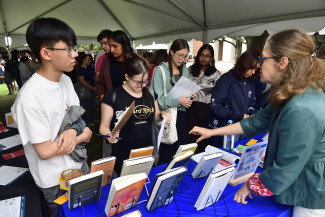
Johns Hopkins UniversityEst. 1876
America’s First Research University
On “The Literal Sense,” a Partial Answers Special Issue in Honor of Jon Whitman

The first sentence of James Joyce’s “The Dead” is “Lily, the caretaker’s daughter, was literally run off her feet.” Helping with the Christmastime party, Lilly oscillates between the front door and the room where the numerous guests leave their overcoats. The expression “run off her feet” is figurative, the word “literally” effecting emphasis and rhythm but hardly keeping its literal sense. Is the literal sense the “basic” sense of literary speech acts? When is there a definable “basic” sense, and what happens if it eludes us? Issue 22.2 of our journal offers partial answers to such questions in the framework of classical antiquity and of Judaic, Christian, and Muslim traditions.
This special issue is ecumenical in intellectual scope and of a broad chronological expanse — from antiquity to modernity. Though Partial Answers: Journal of Literature and the History of Ideas usually publishes papers by distinguished scholars side by side with articles by young literary critics, all the authors of “The Literal Sense” forum are leaders in their fields.
Based on a colloquium organized in Jon Whitman’s honor by Sanford Budick, this forum is devoted less to Whitman’s many years of work on allegory (see his Allegory: The Dynamics of an Ancient and Medieval Technique, Oxford University Press and Harvard University Press, 1987, and his edited collection Interpretation and Allegory: Antiquity to the Modern Period, Brill 2000) than to his on-going research on what may be seen as the opposite of allegory — the literal sense of language in its relation to interpretive procedures. If in an allegorical expression, “something is said, and something else is meant, it is conventional to think that in the case of ‘literal’ discourse, people say just what they mean and mean just what they say” (Whitman 212). Like Whitman, the forum calls the latter assumption into question.
In his “Prefatory Postscript,” Jon Whitman outlines the historical development of attitudes to literality, its status and its limits. He raises, among other questions, the problem of the relationship between the literal sense and the issue of ambiguity, both as a predicament of reception and, possibly, as a feature of the very encoding of the text.
As Rita Copeland shows in her article on classical and Christian perspectives, ancient and medieval rhetoricians asserted the need to resolve ambiguity into authorial intention; poets, on the other hand, enhanced the artistic effects of their work by slippages in “the literal sense.” Robert Gleave offers answers to Whitman’s questions about literality (raised in Whitman’s introduction to his 2000 collection) from the platform of Muslim legal hermeneutics, including views on the relationship between grammatical structures and legal categories. Mordechai Z. Cohen takes us to the attitudes of Abraham ibn Ezra, the eminent Biblical commentator who lived and wrote during the Islamic “Golden Age” and was influenced by both Muslim and Christian thinking: he insisted on peshat, the “plain” or “literal” sense of the biblical text as opposite to drash, the sense sought out by scrutiny and interpretation. This article shows that in Ibn Ezra’s exegesis, the understanding of the peshat, the literal sense, is associated with philosophical considerations.
The next three papers involve case studies. How interpretive procedures shed a new light on the would-be literal sense of gesture (Job’s placing his hand over his mouth) is shown in the article of Edward L. Greenstein. Jeremy Cohen’s article moves us towards the times of the Crusades, comparing Judaic and Christian readings of the Song of Songs (Rashi vs. Honorius Augustodunensis) and pointing not only to the different views of the same textual segments but also to the importance of the contemporary interreligious debate and the religious communities’ growing awareness of each other. The forum ends with Michael P. Kramer’s discussion of the way in which Emma Lazarus’s sonnet “The New Colossus” makes a successful bid to reshape the initial literal meaning of the Statue of Liberty by enhancing the theme of asylum and re-mediating the issue of the Hebraic self-fashioning of American history.
The essays imply that seeking the literal sense of a text’s words amidst its ambiguities largely amounts to a pursuit of understanding the world, in its different and changing cultural realities.


